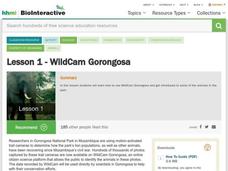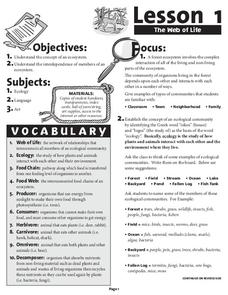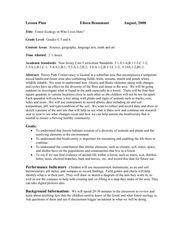Curated OER
Examining the Stages in Ecological Succession
In this ecosystems worksheet, students use illustrations and descriptions of four ponds to determine the order of succession. Students complete 8 fill in the blank questions and 5 short answer questions.
Curated OER
Decision Making a Mock Town Meeting on a Proposed Tank Farm
Students identify the potential hazards to the water supply. In this ecology lesson, students role play a town hall meeting to discuss the proposal of a storage tank construction in their place. They present their arguments and vote on a...
Curated OER
You Are What You Drink!
Students explore water treatment systems. In this water conservation ecology lesson plan, students identify and explain several processes used for water treatment and define related vocabulary after listening to content information given...
Curated OER
Who Owns Water
Students role play how water is allocated to different holders of water rights. In this ecology lesson, students identify the different water rights available. They explore problems associated with water use including drought, degraded...
Howard Hughes Medical Institute
Lesson 1: WildCam Gorongosa
Take a walk on the wild side! Episode one of an eight-part series of interactive lessons regarding Gorongosa National Park invites learners to become a part of the citizen science community. Scholars read a brief overview of the trail...
Curated OER
Prairie Restoration and Prairie Ecology
Students collect data as they identify and classify native prairie plants and insects. They create their own population study using a variety of sampling techniques to determine the population density of various species. Students...
Curated OER
Arizona Plant Booklet: An Introduction to Arizona Plants & Cacti
Young scholars explore variety of plants & cacti in their Arizona community by collecting samples and taking photographs. Can be adapted to other areas.
Curated OER
Coastal Ecosystems: Salt Marshes and Mangroves
What factors drive a coastal ecosystem? Marine biology or environmental studies classes find out by viewing this presentation. They meet the fauna and flora of salt marshes and mangroves. They are familiarized with threats to these...
Forest Foundation
The Web of Life
Producers, herbivores, carnivores, omnivores, decomposers. To begin a study of the forest ecosystem, learners examine the connections among the members of ecological communities.
Curated OER
Exploring Arizona's Biotic Communities Lesson 4: Which Team Are You On?
Who is not drawn to trading cards? In this lesson, junior ecologists create a trading card of an animal or plant from one of Arizona's biotic communities. Gorgeous sample cards are provided in the lesson plan as well as a plethora of...
Curated OER
Habitat Basics
First graders get out and explore two different habitats to examine how each one meets the needs of the plants and animals that dwell there. They discuss what they've learned about animal habitats as they explore the outdoor environment....
Curated OER
WWW = World Wide Wildlife
Through video, internet research, and hands-on activities, learners conduct a study of the interdependence between animals and the habitats they live in. They conduct Internet research independently in order to complete a report on a...
Curated OER
Pond Ecology
Fifth graders examine pond ecology, testing how temperature affects the respiration rate of fish. They collect various living things found at a pond, and identify the animal and plant life discovered. They observe a pond community in an...
Curated OER
Ecological Succession
Pupils examine succession in different communities. For this investigative lesson students study ecological succession and complete several assignments.
Curated OER
Forest Ecology or Who Lives Here?
Pupils explore a hardwood forest. In this forest ecology lesson, students examine the diversity and animals and plants as they explore their habitats at Poricy Park Conservatory. Pupils determine how biodiversity and abiotic elements...
Curated OER
Mini-Unit: Natural Resources
Students explore how their choices affect others. In this character development and ecology lesson, students debate choice-making issues. Students listen to The Lorax by Dr. Seuss and identify choices the characters made about tree...
Curated OER
Sense of Place
Young scholars identify the major folk regions of Louisiana and the relationship between folklife, geography, and ecology. They give deeper thought to what makes their own community unique, what their sense of place actually is. ...
Curated OER
Entomologists on Safari: On the Hunt for Mosquitoes
Students research about the symptoms of West Nile Virus. For this health lesson, students play the role of scientists investigating mosquito activity in a fictional community. They suggest ways to prevent West Nile virus infection by...
Curated OER
Down, Dung and Dirty
Students observe the changes seen in succession and the biodiversity of a community through its species richness and evenness. They create a dung culture in a clear plastic cup from horse, goat or cow dung then observe the numbers of...
Curated OER
Population Growth
Students grow duckweed, observe what happens when an organism population is allowed to grow without predation or competition, view videos about invasive species, and develop a proposal for controlling the growth of an invasive species in...
Curated OER
Rainforests of the Sea
In this ecology worksheet, students read and study about coral reefs using online resources to complete 8 short answer questions. They watch a video related to the topic.
Curated OER
Machines: Designing Form and Function
Young scholars design a boat model with simplified steam engine. In this ecology activity, students compare renewable and nonrenewable energy sources. They determine the efficiency of their boat model.
Curated OER
Where's the Drip?
Students detect water leaks. In this water conservation ecology lesson plan, students take a tour of the school grounds and identify sources of water and possible leaks. Students report leaks to the custodian and administration.
Kentucky School for the Deaf
Levels of Organization within an Ecosystem
From tiny organisms to entire biomes, young scientists examine the interdependent relationships tying all living and non-living things together with this collection of ecology resources.

























